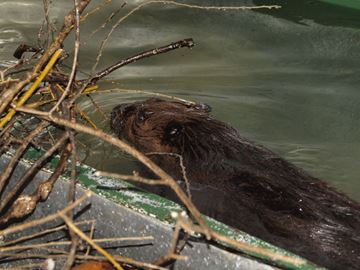There’s something about winter that gets sport writers whimsically musing about beavers under the snow. Maybe because its suddenly too cold to go fishing or just because they’re jealous of the fur. I don’t know why, but trust me, it’s a thing. This is from the Idaho Statesman.
Roger Phillips: Idaho snow shows nature that often hides
Still don’t know all the details, but when you see a freshly eaten tree trunk and a slide with packed snow down to the water, it’s obvious there’s been a beaver working within the last few days, and likely at night.
I also saw a U-shaped path between two ponds where the beaver crossed enough times to compact and melt the snow into a little bobsled run.
Heck, maybe it did it for fun.
Ahh beaver tracks in the snow! Something Martinez will surely never know. Although I have seen historic photos of a snow covered main street from the early 1900’s. I suppose it could happen! Any more winter musings out there? This is from Toronto.:
Beavers, on the other hand, have an enviable winter set-up. The largest rodent in North America, beavers have an impressive work ethic. Second only to man, beavers change the environment to fill their requirements.
Unlike man, beavers only build habitat-changing dams when they need to increase water levels for food storage and protection from landlocked predators. And beaver dams don’t only benefit beavers; they also play an important role in creating, maintaining and restoring wetland environments.
In the winter, the beavers rely on an underwater food cache they stock with wood before temperatures drop. If the water freezes they still have access to food. Beavers mate for life, and have up to six kits a year. The young stick around for two years before leaving to set up their own lodge. That’s plenty of company to ride out a long winter.
Well yes, beaver accommodations are enviable. As is their fur. Which was envied so much they were nearly rendered extinct. I guess the point of your article is that we should all be cozy like beavers? I can’t say I disagree. This last one is from Minnesota and its actually well-written. I can’t think if anything flip to say about Larry Weber’s article which, considering I know the plot, was surprisingly engrossing.
A visit to a beaver pond
The resident beaver family has been very busy lately. The woods at the shore is scattered with chewed-off stumps of largely aspens, but I also note some willows and poplars. The fallen trees, mostly small, less than 6 inches in diameter, lay on the forest floor. Once the trees are downed, branches are bitten off and taken to the lodge out in the water. The largest ones are placed on the lodge to add more of a fortification and protection for the beavers.
Protection is from the winter weather, but also predators. In like manner, some stout branches are used to strengthen the dam. This wood, plus rocks and mud, will make this structure solid and keep the water level of the pond high enough to allow the beavers to swim about as they enter and exit their house from below without being frozen shut. In recent years, I have found a few nearby ponds where winter cold caused the ice to form deep and block the beaver’s swimming and feeding beneath the ice.
But the beavers are doing much more than fortifying the lodge and dam for winter. They are also preparing a food cache to get through this time.
All through the warm weather, they were able to swim ashore to cut and snack on nearby arboreal meals. Ice will curtail such activities and so the beavers use saplings and smaller and thinner branches of their cut trees to stash food in preparation for the long freeze-up. Now, in the freedom of no ice, they drag the branches back near the lodge where they store large numbers of this winter food. This cache of twigs and branches will freeze in the ice, but is close enough so that the food is accessible as the beavers swim under the ice and bite off morsels for meals.
It’s a long time from now until the thaw next spring and so the beavers try to store enough woody food to last this whole frozen time. And from what I see here today, in mid-November, they appear to be doing just that.
It is so nice to read something from someone who knows both how to write and how to observe. Thanks Larry. And thanks beavers for being so hardy that you make it bravely through the winter on your own. At the moment we’re just hoping that it will rain a little in California. Then we’ll start worrying about the snowpack.



 People should envy the beaver for its winter set-up – a cozy cottage stocked with wood, food and family
People should envy the beaver for its winter set-up – a cozy cottage stocked with wood, food and family




































